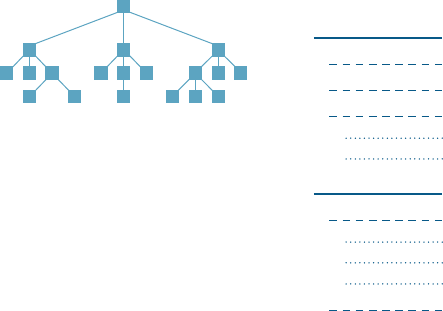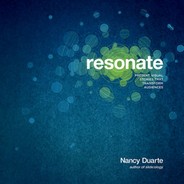
128 Resonate
The odds are high that you’ve been the victim of a mean-
dering presentation. Unorganized presentations follow
an invisible, neurotic pathway that only makes sense to
the presenter. When an audience is unable to recognize
structure, it’s usually because the presenter either didn’t
have time to organize the information or didn’t care
enough to package the content in a way the audience
could easily process.
Presentations that follow rabbit trails lead nowhere and
leave the audience lost in a confused maze of dead ends.
Without structure, your ideas won’t be solid. Structure
strengthens your thinking. But many presentations today
migrate away from the purity and clarity of structure.
Don’t fall for this temptation.
The most widely used structure for presentations is topi-
cal. A logic tree and outline are common forms to help
visualize structure:
Make Sense
Notice how all the supporting information hangs off the
larger topics. Points are held together under one unifying
big idea from which the topics cascade down.
The chief marketing officer of a public company recently
shared with me a process modification she made while
developing messages for her CEO. Traditionally, she and
her team would “pitch” ideas to the CEO by firing up a
slide show. About three slides in, he would inevitably
throw a wrench in by letting them know that this or that
piece of content should be included. If he’d held onto his
shorts, he would have seen that his favorite pet content
was there, but he wouldn’t have seen it for another
fifteen minutes of slides. She laughed and said that the
last time she worked with him, her team had a monu-
mental idea. Ditch the slides and give him a substantial
outline. He quickly absorbed the structure, saw his pet
content immediately, and spent the bulk of the hour
building on the ideas they proposed. Long live outlines!
There are benefits to looking at a presentation’s struc-
ture holistically.
It creates a snapshot of the structure so you’re look-•
ing at the whole and not the parts, which keeps you
focused on the construct instead of the details.
It ensures that you have one clear big idea bolstered •
by supporting topics.
It filters out tangential subtopics that may fall within •
the topic but that don’t purely support the single
big idea.
It helps the review team get a quick read on the struc-•
ture and messages, saving them time so they can give
more thoughtful feedback.
TREE OUTLINE
I.
A.
B.
C.
1.
2.
II.
A.
1.
2.
3.
B.
Big Idea
CH006.indd 128CH006.indd 128 8/16/10 5:01:34 PM8/16/10 5:01:34 PM

Structure Reveals Insights 129
Organizational Structures
There are several interesting ways to organize supporting
content. Though the most common is topical, a presen-
tation’s structure can incorporate other less customary
organizational patterns. These patterns can be used as
the overarching structure to replace a topical one, or to
arrange content within a subtopic.
These four structures have contrast inherently built
into them and work for persuasive presentations:
Problem-solution:• Arrange information by stating
the problem and then the solution. Establishing that
there’s a problem helps convince people of the need
for change.
Compare-contrast:• Arrange information according
to how two or more things are different from or
similar to one another. Insights surface when infor-
mation is put into this context.
Cause-effect:• Arrange information to show the dif-
ferent causes and effects of various situations. This is
effective when promoting action to solve a problem.
Advantage-disadvantage:• Arrange information into
“good” or “bad” categories. This helps the audience
weigh both sides of an issue.
These four structures have a natural storylike form that
creates interest in presentations:
Chronological: • Arrange information related to
events according to their time progression (forward
or backward). This is best used if a topic is generally
understood in terms of when events transpired.
Sequential: • Arrange information according to a
process or step-by-step sequence. This is usually
used in a report or to describe a project rollout.
Spatial: • Arrange information according to how
things relate together in a physical space.
Climactic: • Arrange information in order of impor-
tance, usually moving from the least to most
important point.
Choose the organizational structure that makes the
most sense for your message. Whichever structure you
use, guide the audience through it with clear verbal or
visual cues that clarify where you are and where you
are taking them.
CH006.indd 129CH006.indd 129 8/16/10 5:01:34 PM8/16/10 5:01:34 PM
..................Content has been hidden....................
You can't read the all page of ebook, please click here login for view all page.
